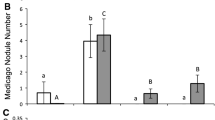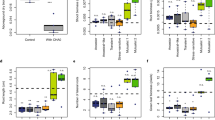Abstract
Genotypes of the annual legume Amphicarpaea bracteata vary in their degree of specialization toward different nitrogen-fixing bacteria. Plants of lineages “Ib” and “II” are specialized for mutualism with a limited group of bacterial genotypes. Lineage “Ia” plants are symbiotic generalists, interacting with all bacteria associated with specialist (Ib and II) plants, and also with a distinct class of bacteria that only fix nitrogen with lineage Ia plants. The relative performance of generalist and specialist plant lineages was measured in four symbiotic environments: (1) in the absence of nitrogen-fixing bacteria, (2) with bacteria with broad host ranges, (3) with bacteria specialized on lineage Ia hosts, and (4) with a mixture of the bacteria with broad and narrow host ranges. In the presence of bacteria with broad host ranges, the relative performance of different plant lineages was inconsistent among experimental replicates. However, lineage Ia plants had nearly 3 times higher total biomass and 6 times higher seed biomass than lineage Ib or II plants when grown with bacteria specialized on Ia hosts. When exposed to a mixture of bacteria with broad and narrow host ranges, generalist plants had 72% higher total biomass and >100% higher seed biomass than specialist plants. These results imply that in diverse natural populations, where all plants have a choice of symbiotic partners, mutualistic interactions are likely to foster competitive exclusion rather than stable coexistence of different plant lineages.
Similar content being viewed by others
References
Bottomley PJ, Cheng H, Strain SR (1994) Genetic structure and symbiotic characteristics of a Bradyrhizobium population recovered from a pasture soil. Appl Environ Microbiol 60:1754–1761
Chanway CP, Holl FB, Turkington R (1989) Effect of Rhizobium leguminosarum biovar trifolii genotype on specificity between Trifolium repens and Lolium perenne. J Ecol 77:1150–1160
Chanway CP, Holl FB, Turkington R (1990) Specificity of association between Bacillus isolates and genotypes of Lolium perenne and Trifolium repens from a grass/legume pasture. Can J Bot 68:1126–1130
Chanway CP, Turkington R, Holl FB (1991) Ecological implications of specificity between plants and rhizosphere micro-organisms. Adv Ecol Res 21:122–157
Devine TE (1987) A comparison of rhizobial strain compatibilities of Glycine max and its progenitor species Glycine soja. Crop Sci 27:635–639
Devine TE (1988) Role of the nodulation restrictive allele Rj 4in soybean evolution. J Plant Physiol 132:453–455
Fitter AH (1977) Influence of mycorrhizal infection on competition for phosphorus and potassium by two grasses. New Phytol 79:119–125
Hartnett DC, Hetrick BAD, Wilson GWT, Gibson DJ (1993) Mycorrhizal influence on intra- and interspecific neighbour interactions among co-occurring prairie grasses. J Ecol 81:787–795
Hetrick BAD, Wilson GWT, Hartnett DC (1989) Relationship between mycorrhizal dependence and competitive ability of two tallgrass prairie grasses. Can J Bot 67:2608–2615
Kuykendall LD, Saxena B, Devine DE, Udell SE (1992) Genetic diversity in Bradyrhizobium japonicum Jordan 1982 and a proposal for Bradyrhizobium elkanii sp. nov. Can J Microbiol 38: 501–505
Law R (1985) Evolution in a mutualistic environment. In: Boucher DH (ed) The biology of mutualism. Oxford University Press, New York, pp 145–170
Leung K, Strain SR, Bruijn FJ de, Bottomley PJ (1994) Genotypic and phenotypic comparisons of chromosomal types within an indigenous soil population of Rhizobium leguminosarum bv. trifolii. Appl Environ Microbiol 60:416–426
Lie TA (1978) Symbiotic specialization in pea plants: The requirement of specific Rhizobium strains for peas from Afghanistan. Ann Appl Biol 88:462–465
Lie TA, Engin M, Pijenborg J, Anlarsal E (1987) Co-evolution of the legume-Rhizobium association. Plant Soil 100:171–181
Mytton LR (1975) Plant genotype X Rhizobium strain interactions in white clover. Ann Appl Biol 80:103–107
Nutman PS, Read MP (1952) Symbiotic adaptation in local strains of red clover and nodule bacteria. Plant Soil 4:57–75
Parker MA (1991a) Local genetic differentiation for disease resistance in a selfing annual. Biol J Linn Soc 42:337–349
Parker MA (1991b) Nonadaptive evolution of disease resistance in an annual legume. Evolution 45:1209–1217
Parker MA (1994) Evolution in natural and experimental populations of Amphicarpaea bracteata. J Evol Biol 7:567–579
Parker MA (1995) Plant fitness variation caused by different nutualist genotypes. Ecology 76:1525–1535
Parker MA, Wilkens RT (1990) Effects of disease resistance genes on Rhizobium symbiosis in an annual legume. Oecologia 85: 137–141
Sinclair TR, Soffes AR, Hinson K, Albecht SL, Pfahler PL (1991) Genotypic variation in soybean nodule number and weight. Crop Sci 31:301–304
Spoerke JM, Wilkinson HH, Parker MA (1996) Nonrandom genotypic associations in a legume-Bradyrhizobium mutualism. Evolution 50:146–154
Thompson JD, Turkington R, Holl FB (1990) The influence of Rhizobium leguminosarum biovar trifolii on the growth and neighbour relationships of Trifolium repens and three grasses. Can J Bot 68:296–303
Turkington R, Holl FB, Chanway CP, Thompson JD (1988) The influence of microorganisms, particularly Rhizobium, on plant competition in grass-legume communities. In: Davy AJ, Hutchings MJ, Watkinson AR (eds) Plant population ecology. Blackwell, Oxford, pp 343–366
Turner BL, Fearing OS (1964) A taxonomic study of the genus Amphicarpaea (Leguminosae). Southwest Nat 9:207–218
Turner GL, Gibson AH (1980) Measurement of nitrogen fixation by indirect means. In: Bergersen FJ (ed) Methods for evaluating biological nitrogen fixation. Wiley, New York, pp 111–138
Wilkinson HH, Spoerke JM, Parker MA (1996) Divergence in symbiotic compatibility in a legume-Bradyrhizobium mutualism. Evolution 50:1470:1477
Young JPW (1985) Rhizobium population genetics: enzyme polymorphism in isolates from peas, clover, beans and lucerne grown at the same site. J Gen Microbiol 131:2399–2408
Author information
Authors and Affiliations
Rights and permissions
About this article
Cite this article
Wilkinson, H.H., Parker, M.A. Symbiotic specialization and the potential for genotypic coexistence in a plant-bacterial mutualism. Oecologia 108, 361–367 (1996). https://doi.org/10.1007/BF00334662
Received:
Accepted:
Issue Date:
DOI: https://doi.org/10.1007/BF00334662




